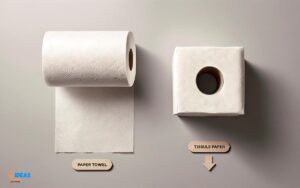How to Cut down on Paper Towel Use
To cut down on paper towel use, use reusable cloth towels and napkins instead. This simple switch can greatly reduce waste and save money in the long run.
When it comes to sustainability, every small change counts. One practical way to reduce waste in your home is by reducing your use of paper towels. Not only are they single-use items that contribute to landfill waste, but the production of paper towels uses up valuable resources and contributes to deforestation.
By switching to reusable cloth towels and napkins, you can significantly cut down on your environmental impact while saving money in the long run. In this article, we’ll explore some tips for reducing your reliance on paper towels in the home, including eco-friendly alternatives and simple lifestyle changes that can make a big difference.
Understanding The Environmental Impact Of Paper Towels
The convenience of using paper towels is hard to ignore. But have you ever considered the environmental impact of your paper towel use? Every household in the us uses an average of 80 rolls of paper towels every year, which means around 13 billion pounds of paper towels go into landfills every year.
Let’s dive deeper into the environmental impact of disposable paper towels.
The Resource-Intensive Paper Towel Manufacturing Process
The paper towel manufacturing process is resource-intensive and has a significant impact on the environment. Here are some key points:
- The production of paper towels requires cutting down trees, which leads to deforestation and habitat loss.
- It takes around 17 trees and 20,000 gallons of water to produce a single ton of paper towels – which are often used just once and thrown away.
- The manufacturing process involves the use of toxic chemicals like chlorine bleach and formaldehyde, which pollute water and air.
The Negative Impact Of Disposable Paper Towels On The Environment
Disposable paper towels pose a significant threat to the environment. Here are some of the key points:
- The trees cut down to make paper towels cannot absorb carbon dioxide, leading to increased greenhouse gas emissions.
- The disposal of paper towels in landfills leads to the emission of methane, a potent greenhouse gas that contributes to climate change.
- Paper towels are also non-recyclable, which means they continue to contribute to landfills.
By now, you must have realized how your paper towel use can impact the environment. The good news is that you can cut back on your paper towel use and make a difference. You can switch to eco-friendly alternatives like washable cloths and rags that are reusable and biodegradable.
Together, we can take small steps to conserve our planet’s resources and strive for a greener future.
Simple And Effective Strategies To Reduce Paper Towel Use
Switching To Reusable Alternatives
One of the most effective strategies to reduce paper towel use is switching to reusable alternatives. Here are some great options to consider:
- Cloth napkins: Cloth napkins not only save money but also add a touch of elegance to your dining experience. There are plenty of reusable options available in online marketplaces.
- Dishcloths: Dishcloths can be just as efficient as paper towels for kitchen cleanups. They are also reusable and will save you money in the long run.
- Handkerchiefs: Handkerchiefs may seem old-fashioned but are super convenient to carry around and use. Plus, they are softer on your nose than scratchy tissues.
- Towels: Instead of using paper towels for spillages, opt for reusable towels. Keep them handy in the kitchen and bathroom.
Making Small Lifestyle Changes
Making small lifestyle changes can substantially reduce paper towel usage over time. Here are some ideas to get you started:
- Consider a drying rack: Get a drying rack for your dishes instead of using paper towels to dry them.
- Use washable sponges: Washable sponges are a great alternative to paper towels when cleaning surfaces and kitchen appliances.
- Break the habit: Instead of using paper towels by default, pause for a moment and think if there is a better alternative.
- Try a no-waste lifestyle: Be conscious of your paper towel usage and try to be more sustainable with all aspects of your life.
Incorporating Organizational Habits
Incorporating organizational habits will help you reduce paper towel usage and keep your home tidier too. Here are some tips:
- Use designated cleaning cloths: Assign different color cloths for different areas: yellow for the kitchen, blue for the bathroom, etc.
- Use a napkin holder: Old napkin holders can be repurposed to store cloth napkins making them a convenient option.
- Keep a bin or basket nearby: Have a bin or basket nearby solely for dirty towels and clothes, making it easier to wash them at once.
- Store towels around the house: Keep towels accessible and in easy to reach locations, preventing the use of paper towels.
By adopting these simple and effective strategies, you can reduce your paper towel usage and make a positive impact on the environment. Remember, small changes can make a big difference!
Diy Reusable Alternatives To Paper Towels
Do your part in promoting a zero-waste lifestyle by cutting down on paper towel use. Here are three diy alternatives to help you reduce waste:
Diy Cloth Napkins And Unpaper Towels
Cloth napkins and unpaper towels are long-lasting replacements for paper napkins and towels. Making them is easy – simply follow these steps:
- Cut out squares from an old t-shirt or cloth.
- Hem the edges of the cloth squares to prevent fraying.
- Use and wash them like you would regular napkins or paper towels.
Not only are they eco-friendly, but they also come in various colors and designs that match your kitchen aesthetic.
Diy Reusable Cleaning Wipes
Cleaning wipes are incredibly convenient but unfortunately come with excess packaging. Here’s how you can make your own reusable cleaning wipes:
- Cut up old towels or clothes into small squares.
- Mix equal parts white vinegar and water into a spray bottle.
- Spray the solution onto the cloth squares and use them to wipe surfaces.
- Wash them thoroughly after use and reuse them.
This affordable and easy-to-do alternative helps reduce plastic waste, saves money, and fits perfectly in your cleaning routine.
Diy Handkerchiefs And Tissues
When it comes to reducing paper towel use, don’t forget about handkerchiefs and tissues! Making your own is simple – just follow these steps:
- Cut out squares from an old t-shirt or soft cloth.
- Hem the edges to prevent fraying.
- Use them as you would regular tissues or disposable handkerchiefs.
- Wash and reuse them as needed.
This diy alternative is budget-friendly, hygienic, and sustainable. Plus, the fabric is incredibly soft on your skin!
Incorporating these eco-friendly alternatives into your daily routine can greatly reduce waste and help create a healthier planet – one diy project at a time.
Overcoming Challenges And Sticking To Your Paperless Plan
Are you finding it challenging to stick to your paperless plan? Don’t worry; you are not alone. Often, we tend to face resistance from family and friends or experience a lack of progress, leading to frustration and ultimately quitting our paperless plan.
However, with some effort and the right mindset, you can overcome these challenges and stick to your paperless plan. Below are some tips to help you:
Dealing With Resistance From Family And Friends
Resistance from family and friends can be discouraging, but remember why you started the paperless journey in the first place. Here are some ways to deal with resistance from family and friends:
- Communicate the benefits of going paperless, such as saving money and reducing waste.
- Discuss and come up with an agreeable plan, such as designating a specific area for paperless documents or identifying the paperless tasks you can do together.
- Stay positive and determined. Your enthusiasm and dedication may inspire others to follow your lead.
Tracking Paperless Progress And Success
Tracking your paperless progress and success is essential to stay motivated and on track. Here are some ways to keep track of your paperless progress:
- Use software such as evernote or google drive to track your paperless journey and store your digital documents.
- Set a goal and timeline to go paperless and break it down into smaller achievable tasks.
- Track your paperless expenses such as saving on paper and printing costs. Celebrate and reward yourself for meeting milestones.
Celebrating Milestones And Encouraging Accountability
Celebrating milestones and encouraging accountability are crucial in maintaining motivation and staying on track. Here’s how you can encourage accountability:
- Share your progress with others, such as family and friends or social media groups.
- Celebrate your achievements by rewarding yourself or doing something you enjoy.
- Join a community or group of like-minded individuals to share your experience and receive support.
Remember, going paperless is a journey and not a destination. It takes effort and determination to stick to the plan, but the benefits of saving money, reducing waste, and being organized and efficient are worth it. Keep going, and you will be amazed at what you can achieve.
Frequently Asked Questions On How To Cut Down On Paper Towel Use
How Many Paper Towels Does An Average Person Use In A Day?
An average person uses 2-3 paper towels per use and 17 trees a year.
What Are The Environmental Impacts Of Using Paper Towels?
Using paper towels contributes to deforestation, clogs landfills and causes pollution.
What Are Some Alternatives To Paper Towels?
Some alternatives are cloth towels, bamboo towels, sponges, washable wipes, and air dryers.
How Much Money Can You Save By Cutting Down On Paper Towel Use?
You can save approximately $100 a year by reducing your paper towel usage.
Conclusion
As we conclude our discussion on how to cut down on paper towel use, it is essential to recognize that small changes can make a big impact on the environment and our wallets. By replacing paper towels with reusable towels, purchasing paper towels made from recycled materials, or air-drying our hands, we can decrease our carbon footprint and reduce waste.
It is also vital to educate ourselves and others on the significance of minimizing paper towel use, as well as exploring alternative ways to reduce our overall waste and impact on the environment. By adopting these habits, we can contribute to a greener and more sustainable future.
Let us all take responsibility and make a positive change, one paper towel at a time!






